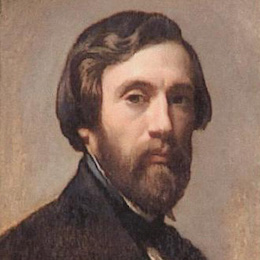Charles Gleyre
1806 (Chevilly (canton de Vaud)) / 1874 (Paris)
"Truth, life and nature did not exist for this man": at the end of a short visit to his studio, the young Monet was right in one sentence about Charles Gleyre. His painting, which had become "worm-eaten", was relegated by posterity to the camp of the most disembodied academicism. A misanthropic ascetic - "sober, discreet, elegant and noble" according to some, "a wooden gentleman with a dull mind" according to others - this son of peasants from the canton of Vaud in Switzerland, who taught the rudiments of his art to the musketeers of Impressionism - namely Bazille, Renoir and Sisley -, could not find words harsh enough to describe the attempts of the young realists: "Landscape, he conceded, is good for young people who have not made their first communion. " Faithful in incisive words to the doxa of his time - which made history painting the absolute summit of art - Gleyre was not, however, faithful in brilliant action, treating the desert landscape like no one else, from his young Italian years spent roaming the countryside to his antediluvian prehistoric visions, passing through his hallucinatory supernaturalism in the East.
Visual :
Charles Gleyre
Selfportrait, 1841
Huile sur toile - 51 x 41 cm
Versailles, Musée national des châteaux de Versailles et de Trianon
© R.M.N./Gérard Blot
"Truth, life and nature did not exist for this man": at the end of a short visit to his studio, the young Monet was right in one sentence about Charles Gleyre. His painting, which had become "worm-eaten", was relegated by posterity to the camp of the most disembodied academicism. A misanthropic ascetic - "sober, discreet, elegant and noble" according to some, "a wooden gentleman with a dull mind" according to others - this son of peasants from the canton of Vaud in Switzerland, who taught the rudiments of his art to the musketeers of Impressionism - namely Bazille, Renoir and Sisley -, could not find words harsh enough to describe the attempts of the young realists: "Landscape, he conceded, is good for young people who have not made their first communion. " Faithful in incisive words to the doxa of his time - which made history painting the absolute summit of art - Gleyre was not, however, faithful in brilliant action, treating the desert landscape like no one else, from his young Italian years spent roaming the countryside to his antediluvian prehistoric visions, passing through his hallucinatory supernaturalism in the East.
Visual :
Charles Gleyre
Selfportrait, 1841
Huile sur toile - 51 x 41 cm
Versailles, Musée national des châteaux de Versailles et de Trianon
© R.M.N./Gérard Blot
